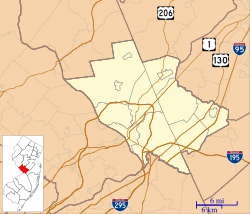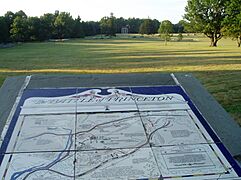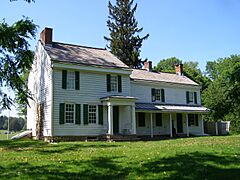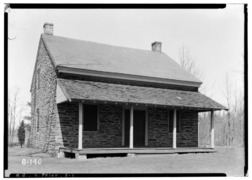Princeton Battlefield facts for kids
|
Princeton Battlefield Historic District
|
|
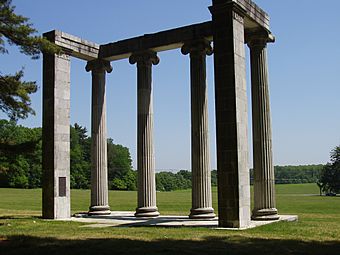 |
|
| Location | Mercer County, New Jersey |
|---|---|
| Nearest city | Princeton |
| Area | 681 acres (276 ha) |
| Website | NJDEP |
| NRHP reference No. | 66000466 (original) 89000761 (increase 1) 100003698 (increase 2) |
Quick facts for kids Significant dates |
|
| Added to NRHP | October 15, 1966 |
| Boundary increases | October 10, 1989 April 26, 2019 |
| Designated NHLD | January 20, 1961 |
The Princeton Battlefield is a very important historical place in Princeton, New Jersey. Here, American and British soldiers fought a major battle on January 3, 1777. This event was part of the American Revolutionary War.
The battle ended when British soldiers surrendered in Nassau Hall. This victory was a big boost for the American forces. It came right after other successes at the Battle of Trenton and the Battle of the Assunpink Creek. These wins greatly improved the spirits of the American army.
Contents
Princeton Battlefield State Park: A Place of History
Princeton Battlefield State Park is a large park that covers about 681 acres. It protects a key part of the Battle of Princeton site. This battle was a major win for General George Washington's American forces. They defeated the British troops here.
The New Jersey Division of Parks and Forestry takes care of the park. You can find it on Mercer Road, south of Princeton University. The park first opened in 1946.
What to See at the Park
The park has many interesting things to explore:
- The actual battlefield where the fighting happened.
- The Clarke House Museum, which is full of history.
- The spot where the Mercer Oak once stood. This famous tree was right in the middle of the battle.
- An Ionic Colonnade, a beautiful monument designed by Thomas U. Walter. He was a famous architect.
- A stone patio that marks the grave of soldiers. Twenty-one British and fifteen American soldiers were buried here.
- A special poem about the site was written by Alfred Noyes, a famous English poet.
You can also find hiking trails in the park. These trails connect to the Delaware and Raritan Canal. They also lead to the Institute for Advanced Study, which is next to the park. The Princeton Battle Monument is also nearby, closer to Princeton University.
The Clarke House Museum: A Glimpse into the Past
The Thomas Clarke House Museum was built in 1772. It belonged to a family of Quakers. The house is decorated to look like it did during the Revolutionary War.
Inside, you can see military items and exhibits about the battle. There is also a library for research. During the battle, a wounded general named Hugh Mercer was brought to this house. Doctors tried to help him, but he sadly did not survive.
Protecting the Battlefield Land
Even though part of the battlefield is a state park, other areas were once in danger. Some groups wanted to build new buildings on a part of the battlefield called Maxwell's field.
The Princeton Battlefield Society worked hard to stop this building project. Many other groups also helped to protect the land. The American Battlefield Trust made a deal to buy almost 15 acres of this important land. They raised money from people and received grants from the National Park Service.
By May 2018, the purchase was complete. This meant the land was saved from development. It ended a long disagreement about how the battlefield land would be used.
Princeton Battlefield / Stony Brook Village Historic District
In 1989, the protected area of the battlefield became even larger. It was named the Princeton Battlefield / Stony Brook Village Historic District. This new district included more historical sites.
The first settlers in Princeton were Quaker farmers. They lived along the Stony Brook, near the battlefield. The Stony Brook Meeting House and Cemetery was already there during the revolution. It was even visible during the battle. Now, this meetinghouse and the old farms are part of the protected historic area.
Gallery
See also


